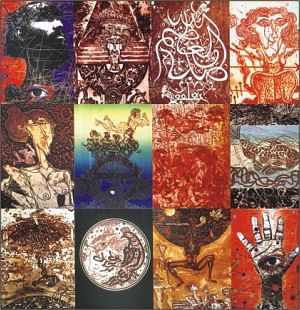Exhibition and workshop
Kalidas' clever craftsmanship
Fayza Haq
Kalidas Karmakar, one of our most renowned print-makers, is conducting a fortnight-long workshop in collaboration with Bengal Foundation on printmaking at Alliance Francaise, Dhaka. Along with the workshop is an exhibition of Kalidas' prints.Kalidas has always used new methods and materials, bringing in the familiar forms with the surreal. He is also influenced by Tantric philosophy. He searches for holy symbols, looking for them in Hindu and non-Hindu beliefs. He works with both symbols and abstractions. Highly skilled in drawing, he has also worked with mixed media and collages. He is one of the first to introduce installation art to Bangladesh. Educated in Poland, France and Japan, Kalidas had his basic training in Fine Arts in Kolkata. Kalidas says, "My primary training in print was under Professor S W Hayter. Hayter is known as the father of colour viscosity, which is a new technique of applying colours to etching. Known methods before him required different plates for each colour. The process is labour, cost and time consuming. Hayter also introduced a workshop-based work system with artists from all over. Earlier artists used to work on their own in their studios. By exchanging ideas and views among themselves they developed new trends in their works." Tracing the history of graphic art, Kalidas says that print-making was regarded as second class art before World War I, though artists like Rubens, Raphael, Goya and Rembrandt did engraving, etching and aquatint. He adds that all major artists up to Pablo Picasso worked in this medium at some stage or another. Kalidas had established his studio at Atelier -17 where eminent artists like Samarjit Rai Chowdhury, Hamiduzzaman Khan and Biren Shome participated. Going through his works on reality and dreams in the prints on display at the Alliance Francaise gallery at the exhibition titled Soul, Soil, Symbols one sees a creation with sweeps of red, yellow, brown and black, with strips of curling white in between. Kneeling, seated and bent figures come together in another brown and white composition with a giant figure in the centre, which appears like a massive tree. In the next composition is a butterfly fluttering over an outstretched palm of a hand, with curls and wiggles on the rest of the paper. This is in burnt umber, black and pale yellow ochre and brings out his mastery over details. Two more prints are pulsating with buoyant colours and abstract images of circles, loops, lines and the formation of an eye in the centre. Flecks of white add harmony to the compositions. Bright orange and brown are balanced with blues and greens. Another moving one has a goddess, with symbols, images and figures surrounding it. On top is a chimney from which floats a burst of leaves and a pale dragonfly. In another work, a peacock is presented with variations of black lines of calligraphy.
|

A collage of Kalidas' works |